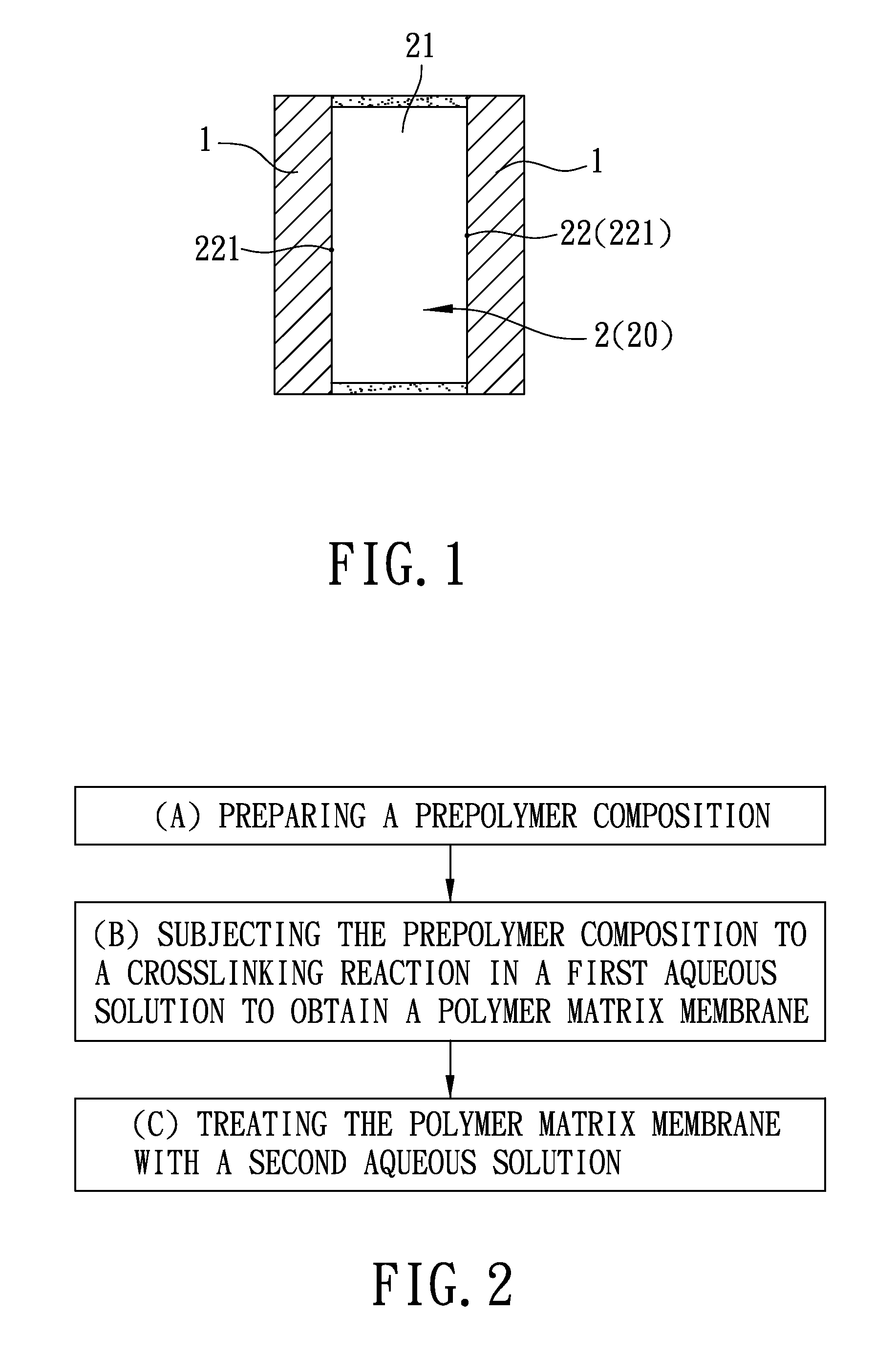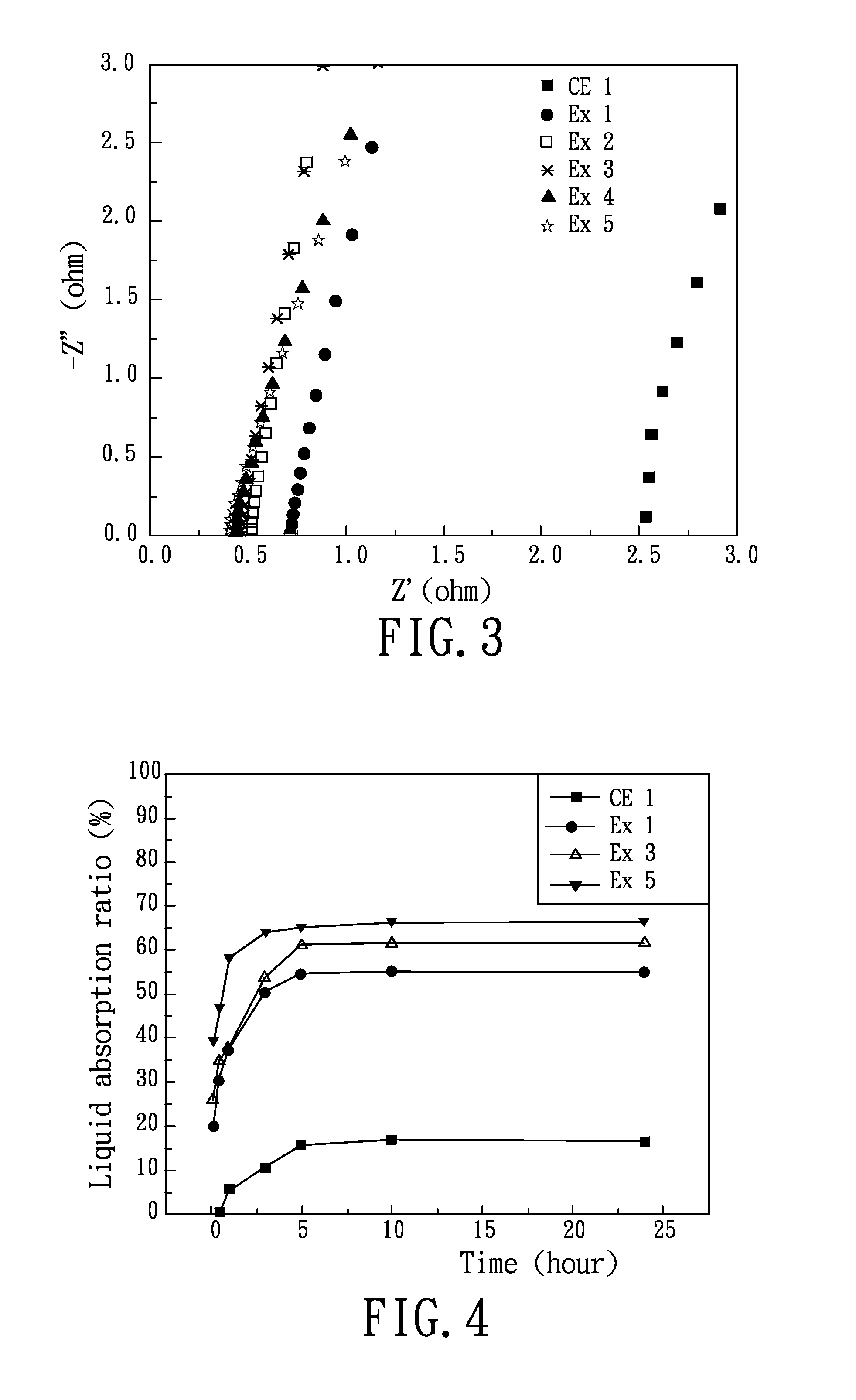Process for preparing a solid state electrolyte used in an electrochemical capacitor
a solid-state electrolyte and capacitor technology, applied in the manufacture of electrolytic capacitors, capacitors, capacitor electrolytes/absorbents, etc., can solve the problems of poor heat stability insufficient energy density of commercial electrochemical capacitors, and unsuitable high-voltage devices, etc., to achieve the effect of higher capacitan
- Summary
- Abstract
- Description
- Claims
- Application Information
AI Technical Summary
Benefits of technology
Problems solved by technology
Method used
Image
Examples
experiment 1
Comparative Example 1 (CE 1)
[0040]PVA (polyvinyl alcohol, Mw=89000˜98000, Tm=200° C., manufactured by Shimakyu's Pure Chemical) was mixed with a water solution at a temperature of 80° C. for 1 hour so as to fully dissolve the PVA to obtain a PVA solution in which the PVA was in an amount of 10 wt %. Then, the PVA solution was stirred at a temperature of 120° C. for 2 hours, followed by cooling to room temperature and drying in a vacuum oven at 40° C. for 12 hours to remove excess water, thereby obtaining a polymer matrix membrane which is a pure PVA membrane.
Examples 1˜5
[0041]PVA was mixed with a water solution at a temperature of 80° C. for 1 hour so as to fully dissolve the PVA to obtain a PVA solution in which the PVA was in an amount of 10 wt %. Then, PAA (polyacrylic acid, Mw=25000, manufactured by Wako Pure Chemical Industries) was mixed with the PVA solution at a temperature of 120° C. for 2 hours, followed by cooling to room temperature and drying in a vacuum oven at 40° C. ...
experiment 2
Examples 6˜9
[0051]PVA was mixed with a diluted sulfuric acid solution at a temperature of 80° C. for 1 hour so as to fully dissolve the PVA to obtain a PVA acid solution in which the PVA was in an amount of 10 wt %. Then, PAA was mixed with the PVA acid solution at a temperature of 120° C. for 2 hours to obtain an acid-based PVA / PAA mixed solution. A predetermined amount of a glutaraldehyde aqueous solution in which the concentration of glutaraldehyde was 25 wt % was further added and mixed with the acid-based PVA / PAA mixed solution for another 2 hours, followed by cooling to room temperature and drying in a vacuum oven at 40° C. for 12 hours to remove excess water, thereby obtaining a polymer matrix membrane which is a PAA / PVA membrane. The PAA was added in each of Examples 6˜9 in an amount of 33 wt % based on the total weight of the polymer matrix membrane. In Examples 6˜9, the added amounts of the glutaraldehyde aqueous solution were 25 μl, 50 μl, 75 μl and 100 μl, respectively.
[...
experiment 3
Examples 10˜14
[0066]In Examples 10˜14, electrochemical capacitors were prepared using five samples of the polymer matrix membranes obtained in Example 3 and 6˜9, respectively. Each polymer matrix membrane was immersed in a sulfuric acid solution of 1.0M for 24 hours to obtain a solid state electrolyte. Two electrodes (i.e., anode and cathode electrodes) for each electrochemical capacitor were made of ruthenium oxide (RuO2), and each was surrounded by a polyimide (PI) frame. When forming each electrochemical capacitor, the solid state electrolyte was screen-printed on an area of one of the electrodes surrounded by the PI frame, and then the other one of the electrodes was disposed on the solid state electrolyte such that the PI frames of the two electrodes were registered with each other. Finally, the two electrodes were subjected to a heat pressing process at 100° C. such that the solid state electrolyte was sealed between the electrodes, thereby obtaining the electrochemical capaci...
PUM
 Login to View More
Login to View More Abstract
Description
Claims
Application Information
 Login to View More
Login to View More - Generate Ideas
- Intellectual Property
- Life Sciences
- Materials
- Tech Scout
- Unparalleled Data Quality
- Higher Quality Content
- 60% Fewer Hallucinations
Browse by: Latest US Patents, China's latest patents, Technical Efficacy Thesaurus, Application Domain, Technology Topic, Popular Technical Reports.
© 2025 PatSnap. All rights reserved.Legal|Privacy policy|Modern Slavery Act Transparency Statement|Sitemap|About US| Contact US: help@patsnap.com



